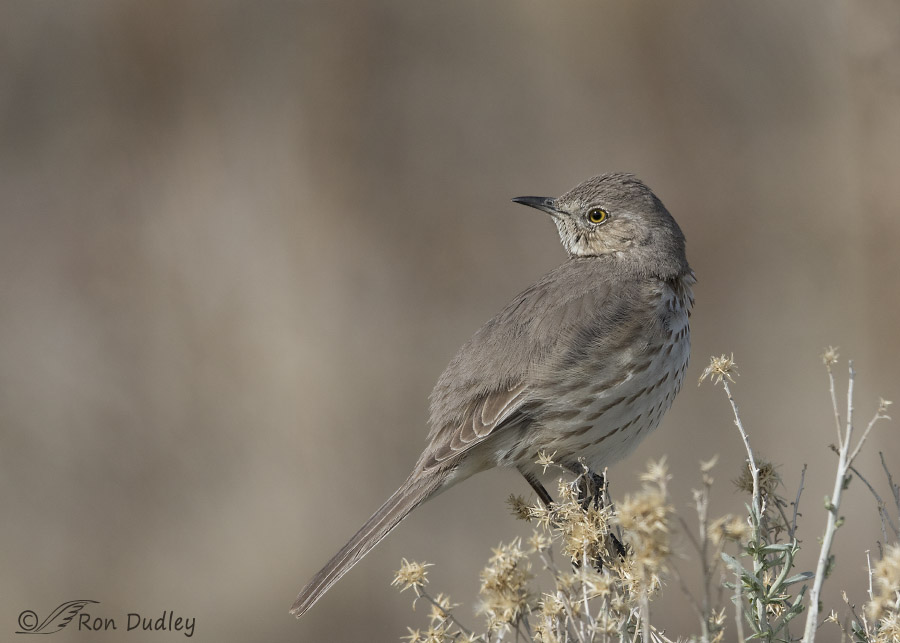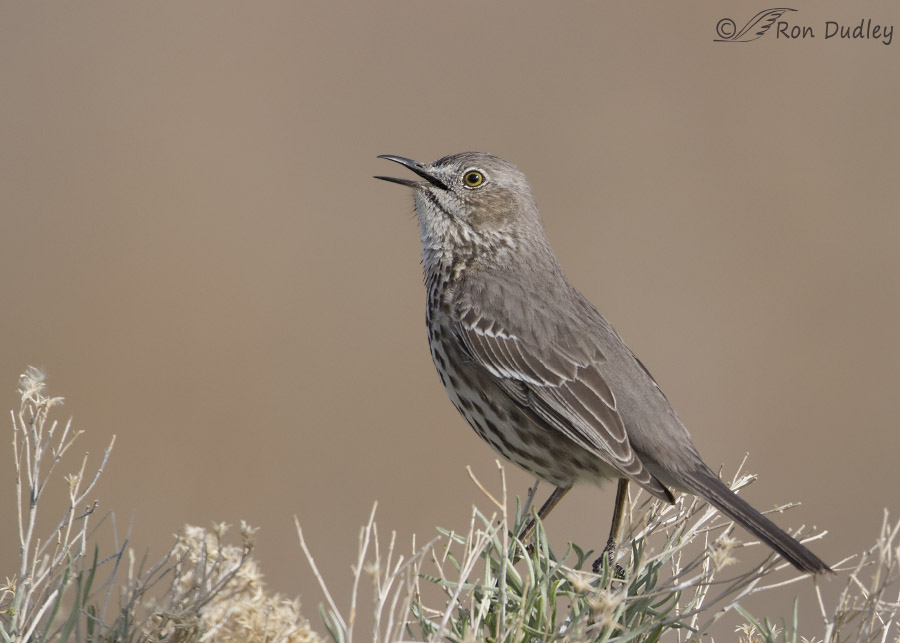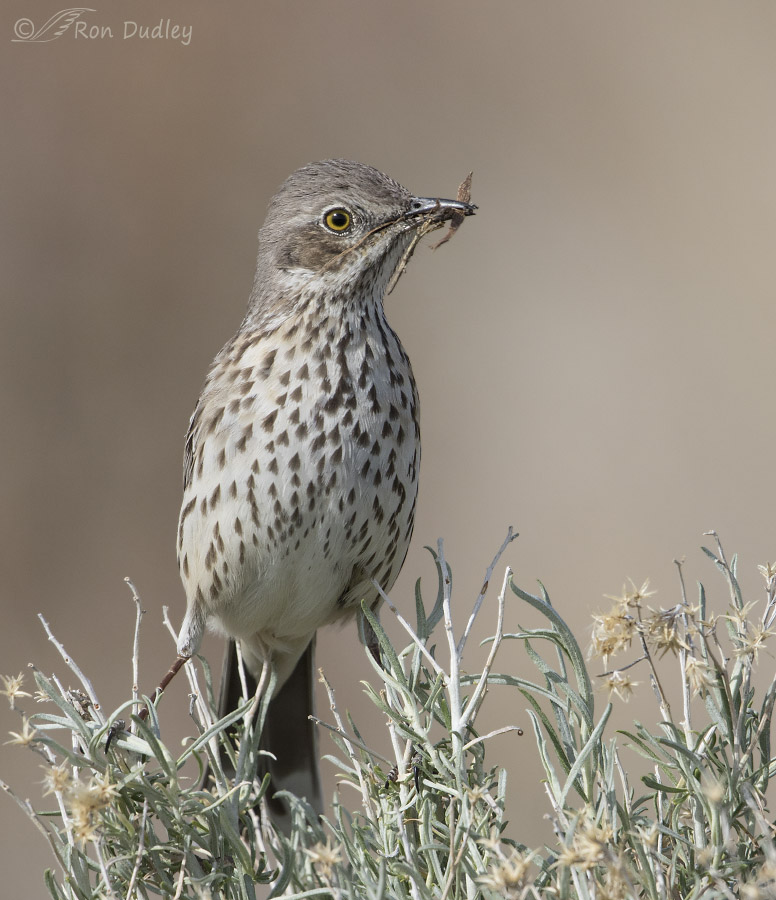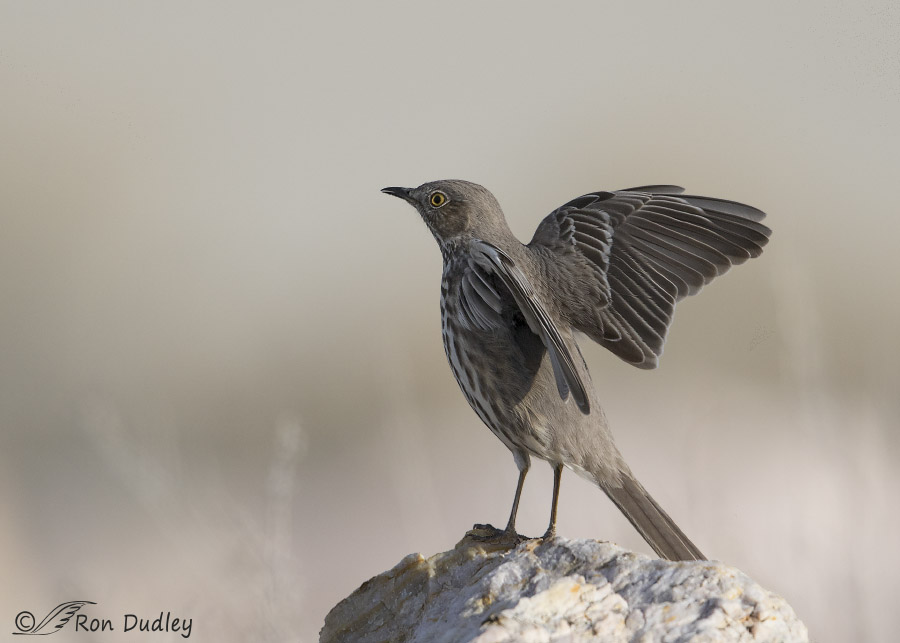It seems that one species or another usually predominates on my trips to Antelope Island. Four days ago it was Sage Thrashers but on another day this time of year it might be Long-billed Curlews, Willets, Black-billed Magpies, Western Meadowlarks, Northern Harriers or Chukars. Or something else.

1/4000, f/7.1, ISO 500, Canon 7D Mark II, Canon EF500mm f/4L IS II USM, not baited, set up or called in
Each spring the nesting thrashers seem to be concentrated in different areas of similar habitat on the island. I instinctively look for them where I found them the previous year but usually find them somewhere else. If you find the right spot and just sit patiently in your vehicle they may eventually begin popping out of the sagebrush and rabbitbrush in good numbers and if you’re lucky they’ll be close. Each of these images was taken on the island three days ago within 39 minutes of each other and in the same general area.

1/2500, f/6.3, ISO 500, Canon 7D Mark II, Canon EF500mm + 1.4 tc, f/4L IS II USM, not baited, set up or called in
This time of year they’re heavily involved in pre-nesting activities including chase flights, displacing other thrashers from perches, performing courtship displays, mate-guarding and establishing and maintaining territory by singing from perches. They’re prodigious singers and a song bout may last for over 20 minutes which may give the photographer plenty of opportunity for singing poses. Like their near relatives the mockingbirds, Sage Thrashers mimic the notes of other species, particularly the Western Meadowlark. It can be a little disconcerting to hear and see the meadowlark’s trill emanating from a thrasher.

1/2500, f/6.3, ISO 500, Canon 7D Mark II, Canon EF500mm f/4L IS II USM + 1.4 tc, not baited, set up or called in
This bird carrying nesting material popped up right in front of me on the sagebrush and it was really too close for me to use the teleconverter but knowing my luck the bird would likely fly off as I tried to remove the tc so I kept it on. I did attempt to shoot the bird vertically for a few frames but that’s an awkward position while handholding from inside my pickup (especially given the rotator cuff problems I’ve been having with my shoulder lately) and most of those shots were either slightly soft or the bird’s face was turned and shaded. As a result, this image is a little tight vertically.
I’m sure other bird photographers have had similar frustrating experiences while shooting vertically and handholding. In the past I’ve used battery packs which provide a vertical grip and extra control buttons (including shutter release) for shooting vertically but overall I find battery packs to be awkward, bulky and unnecessary for my usual style of shooting.
Ron
Addendum: As an afterthought I decided to include one more recent image (taken just over two weeks ago) of a Sage Thrasher demonstrating one if its springtime courtship displays.

1/3200, f/6.3, ISO 640, Canon 7D Mark II, Canon EF500mm f/4L IS II USM + 1.4 tc, not baited, set up or called in
This behavior is called the Bilateral Wing Display. The bird raises and flutters one or both wings for several seconds while it continues to sing (I just happened to catch the beak closed in this shot). It is part of their courtship display and is also thought to function as a threat directed at other thrashers. I didn’t get the best light angle on this shot but it does demonstrate the behavior.


The subtle variation of color fascinates me. At first glance, you might dismiss them as just another grey/brown bird. But when you zoom in on them like this? Wow.
Fantastic series!
Charlotte
Ron,
The “nesting material carrier” really commands my attention. It feels like the actual bird is present. I enjoyed exploring all of the habitat, and the details of this birds feathers. ..especially liked seeing that the procurred twig tip extended to the bird’s right .
Is it the full frame that gives this shot such immediacy? It’s hard for me to stop looking at it.
SUE
Wonderful series. I especially like the one with the nesting material. And the orator (the last one).
“the orator”
Ha, I like that, Susan. Wish I’d thought of it.
Just delightful. As is Patty’s comment about the speech giving. Thank you both.
Hi Ron – I’m like Dick & thought the material was actually a winged insect, until I read your info on that shot. I went back to look more closely at it & could see a stick that was attached to the material lined up very close to the bird’s body. That will teach me to look over the whole photo more carefully. Since I love your photos that should be a fun task!!
Jo Ann, hopefully it won’t be long until I get them with food in their beaks, for their chicks!
Wonderful images and great description of the thrasher’s springtime behavior. I’m with Dick, that “too tight” shot is very pleasing.
Our Northern Mockingbirds and Brown Thrashers are competing for singing endurance records lately. A lot of fun hearing the diverse vocalizations. Thought I had a first-time Tufted Titmouse in the yard last week. Nope. Our mocker got me.
Hope the shoulder gets better soon. (Gentle physical therapy helped mine.)
Wally, I’m glad to hear PT was helpful for your shoulder. Hopefully that’ll suffice for me too. Should know next week.
PS. That isn’t the only “bird brain” spouting off!!!
Looks like that bird is giving a speech in the last shot…a lot of that kind of stuff happening these days….
And it’s only going to get worse, Patty…
I especially like the second and third shots…love that straddled close up!!! When these birds sing, except for the color and length of the tail. They really do remind me of Mockingbirds. Those eyes are riveting! Sorry to hear about rotator cuff problems…must be make shooting very awkward and painful….
Agreed, Patty. The similarities between these birds and mockingbirds are both physical and behavioral. Thank you.
I like all your shots of the Sage Thrasher, but especially the close one with nesting material that almost looks like an insect. That shot immediately brought my eye to the Thrasher’s eye. Man this bird and its eye are tack sharp! Even though you might think it is too close, not me, that is up close and personal, love it!
I tend to like close shots for the detail too, Dick, though that kind of composition doesn’t appeal to everyone. And you’re right – that nesting material does resemble an insect. I hadn’t noticed that. Thank you.